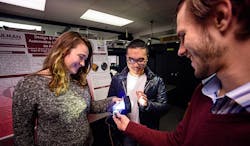LED headlights with freeform optics win Rose-Hulman students global engineering award
IMAGE: Using freeform optics to redesign automotive LED headlights earned first-place honors at the 2018 Global Capstone Design Fair in South Korea. Team members (from left) are Audrey Brand, Zhaowei Chen, and Simon Tsaoussis. Not pictured is Husam Altoonisi. (Image credit: Rose-Hulman Institute of Technology)
A novel freeform optical engineering concept that could refocus the automotive light-emitting diode (LED) headlight industry earned four Rose-Hulman Institute of Technology (Terre Haute, IN) students grand prize honors in the 2018 Global Capstone Design Fair that was part of South Korea’s E2Festa engineering education festival. More than 20 projects from 16 universities across eight countries showcased ideas and prototypes in future technology that could be implemented by business and industry to enhance society.
The students' prototype utilizes freeform optics, a complex concept in LED-based headlights. The technology requires less working parts than current headlight models and uses molded plastic instead of the current practice of metal reflector cones. This would make headlights potentially easier to manufacture, more compact, and cheaper to produce.
Specifically, the Rose-Hulman project enhances headlight technique through light manipulation and shaping. Using non-sequential ray tracing, students designed a 3D freeform lightguide to direct the light source into a road’s legal pattern, without the use of reflectors or bevels. The headlamp is designed to meet automotive regulations for low-beam patterns, and a working prototype was built up from the designed freeform lightguide, high-power white LED source, electronic driving circuitry, and a second projection lens that was also prototyped by the team.
Senior optical engineering student Audrey (Audie) Brand started working on the project last spring through support from Rose-Hulman’s Independent Project/Research Opportunities Program. Adding ideas to the project were Husam Altoonisi, a sophomore mechanical engineering student, and Zhaowei (Zac) Chen, a sophomore optical engineering student, after learning aspects of optics in an advanced physics class. Simon Tsaoussis, a senior engineering physics major, designed and created prototypes of the printed circuit boards for the LED driver.
A functioning prototype of the light guide was created within nine weeks and it took team members approximately five months to achieve satisfactory results with the new technology. Brand presented the group’s findings this summer at an international conference of optics and photonics professionals in San Diego, CA. That’s when the project was selected to be showcased with other college student-inspired innovative projects at E2Festa, an engineering and technology festival in Korea.
"It was an honor to be awarded the grand prize when compared against teams from all over the world that are working to solve problems such varied as braille literacy and smart parking structures," says Brand.
Team members are now striving to improve their prototyping methods as well as overall optical efficiency of their simulations to publish their findings in a prestigious optical engineering journal. Altoonisi and Chen have developed a vacuum forming technique to complete a prototype for the headlamp's projection lens and Tsaoussis has been working on developing alternative techniques of optical surface smoothing.
Visiting optical engineering professor Hossein Alisafaee, the team’s faculty mentor, estimates that the automotive lighting market could exceed $40 billion by 2024. "The future is bright for this technology," he says. "We will keep working and improving and inventing more. I am counting on Rose-Hulman students to demonstrate their refined skills again in other international stages in the future as we move toward new technologies for automotive applications."
Before joining the Rose-Hulman faculty, Alisafaee worked in industry as an optical engineer.
"The technique we've developed at Rose-Hulman is an engineer's dream. There is room for improvement and we will keep working on it, thanks to institutional support. I would be happy to work with industry and introduce our technique to them as well," says the professor. "To the best of my knowledge, this is the very first time a complex LED headlamp is designed based on freeform lightguides. In addition, we invented our lighting technique keeping in mind a retrofit potential for volume production in industry."
Providing technical assistance to the project has been Roger Sladek, technician for the Department of Physics and Optical Engineering. Director of the Center for Applied Optics Studies Sergio Granieri, an associate professor of physics and optical engineering, escorted the team to Korea for the E2Festa.
This is the second time in five years that a project by Rose-Hulman students has been a prize winner at the International Capstone Design Competition, and the first time that a team from the institute has won the grand prize.
SOURCE: Rose-Hulman Institute of Technology; https://www.rose-hulman.edu/news/2018/Students-Innovative-Optical-Headlight-Design-Wins-Global-Contest.html

Gail Overton | Senior Editor (2004-2020)
Gail has more than 30 years of engineering, marketing, product management, and editorial experience in the photonics and optical communications industry. Before joining the staff at Laser Focus World in 2004, she held many product management and product marketing roles in the fiber-optics industry, most notably at Hughes (El Segundo, CA), GTE Labs (Waltham, MA), Corning (Corning, NY), Photon Kinetics (Beaverton, OR), and Newport Corporation (Irvine, CA). During her marketing career, Gail published articles in WDM Solutions and Sensors magazine and traveled internationally to conduct product and sales training. Gail received her BS degree in physics, with an emphasis in optics, from San Diego State University in San Diego, CA in May 1986.
